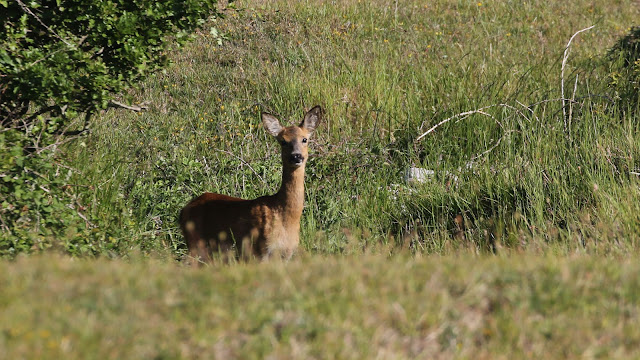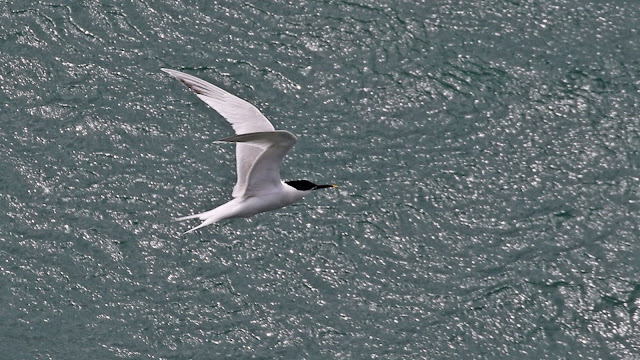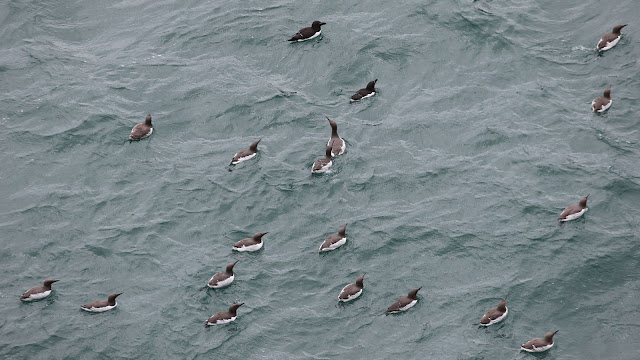It is now time to specialise, find those locations with a summer speciality and so Ian and I crossed the border west again, but this time into Dorset. It doesn't seem like it it but it was four years since we had been here before, Durlston Country Park, a beautiful site just outside Swanage and settled on the cliffs to the west of the town. The journey takes me a little over and hour and a half and we arrived after having to negotiate diversions and closed roads around 6:30 in the morning.
It was clear blue skies but with a very fresh wind as we set off for the cliff path to walk to Dancing Ledge about two and a half miles away. The wind was much stronger on the cliffs compared to the car park and Jackdaws were enjoying the opportunity to perform their acrobatics, others resting on the meadows and bushes.
Several reasons for the trip today with one being to catch up with the sea bird colonies of Guillemots and Razorbills and below on the sea there were small rafts of both birds, the Guillemots in their chocolate brown plumage, the Razorbills jet black.
We were walking into the wind which made the going a little harder, a Roe Deer watched as we approached, the wind would have blown our scent away from it so it probably had picked us out by sight.
As mentioned there were several reasons for being here, three in fact, the sea birds as mentioned, flowers, especially orchids and butterflies, although in the conditions were were not expecting the latter to be abundant. We were lifted a bit though in finding a single Small Heath settled on one of the bramble leaves.
As we walked we were serenaded by Whitethroat singing from within the many bushes, every so often one would break cover and fly up into the air with that scratchy crescendo. At first the walk is sheltered by bushes, we checked the rocks below us as in 2016 whenlast here a Peregrine sat on the rocks out in the open, today they were empty. The path open up into more meadow like conditions when the grass has been grazed, with this came the orchids, the easy to pick out Pyramidal Orchid first.
But close by another of what we were hoping for the Bee Orchid.
The Bee orchid gets its name from its main pollinator - a
species of bee - which is thought to have driven the evolution of the flowers.
To attract the bees that will pollinate the plant, it has flowers that mimic
their appearance. Drawing them in with the promise of love, the bees attempt a
mating. As they land on the velvet-textured lip of the flower, the pollen is
transferred and the poor bee is left frustrated. Sadly, the right species of
bee doesn't occur in the UK, so Bee Orchids are self-pollinated here.
It has a rosette of leaves at ground level and two leaves
that grow up the stem as a sheath. The stem displays a number of relatively
large flowers with pink sepals that look like wings, and furry, brown lips that
have yellow markings on, just like a bee.
Leaving the orchids we walked on above a familiar call introduced the arrival of a Raven overhead.
The path then drops down to a small valley that leads down to a quarry. This is known as Dancing Ledge, and area of Portland Stone that was probably easily accessible to ship by sea. Steps lead down into the quarry
The quarry was covered in thrift that has passed over and pas its best. In amongstit Linnet searched for fallen seeds.
Beyond the ledge there are more cliffs that have auks nesting and out on the water we could see both Guillemot and Razorbills, there was though one more I was hoping for, but to be honest I wasn't holding out much hope. I scoured the sea, the swell hiding the auks intermittently. Then found what I was hoping for, a colourful bill! It was a long way off on the sea but was unmistakably a Puffin.
A rolling sea and a distant bird didn't make the chance of recording this very easy and the photographs are not of the quality I have had of puffins in the past.
We later found out that there are twenty eight birds here, it wasn't clear if they are all breeding pairs. The area where they breed is a little further along and not visible from the footpath. Here there is sufficient soil for them to dig their burrows.
We counted at least three on the water maybe one or two more, and at times they drifted a little closer.
This colony is the furthest colony east on the south coast and it felt quite good that there are Puffins available to see only an hour and a half from home.
As we watched the Puffin and the other auks a dark image flew past us and up into the cliff. I watched it go all the way, but Ian didn't immediately see it. It flew to a ledge that was white from droppings so this was a regular spot. A Peregrine and from the size probably a male.
I thought for a moment we were going to have another "redstart" moment but with the help of a crack in the cliff stone I was able to get Ian onto the bird.
We should not have worried as the falcon sat on its ledge watching the world all around it.
You watch the falcon willing it to do something different but at the same time praying it won't fly off never to be seen again!
A distraction on the cliff above, a Rock Pipit.Back to the Peregrine, I moved around to see if I could get part of the cliff to blur to put the focus on the bird.
A little
A little more, I think this works.
It was clear the bird wasn't going anywhere soon so I turned again to the sea. A Shag passed close to the ledge
The auks were flying in and out of the cliffs, here a Guillemot and Razorbill, showing the difference in the plumage colour.
And tantalisingly the Puffins drifted a little closer too.
Finally some animation from the Peregrine, a scratch and a move around its ledge
You could now sense that something was going to happen, a look around some movement towards the edge of the kedge and then it launched into the air.
Then it headed around the cliff, initially away from us but it then banked over the top of the cliff.
Then came back towards and over our heads and headed away across Dancing Ledge and was lost to view as it headed along the cliffs
Puffin was on the list for today as was the Peregrine so all was good. We decided it was time to go and look for the other target the Bee Orchids. Although we had seen some there was a field back in 2016 where we had seen many and we were hoping for a repeat performance.
Before that though we decided to explore the quarry, it was sheltered and there might be some butterflies. First though was a pair of Rock Pipits. There were lots of posturing with the wings held low and the tail cocked. I couldn't make out if it was a breeding display, or if they were fighting for territory. However it ended with a little battle and both birds flying up in the air.
Some views of Dancing Ledge, first looking east, showing the "ledge".
Looking west towards the cliff where the Peregrine sat.
The quarry floor was covered in many flowers and as I walked around I couldn't hep but think this would be an excellent spot for a Wall Brown, but I couldn't find any. The most striking flowers were the Viper's Bugloss.
Valerian, probably the most numerous
And the Bird's Foot Trefoil, which, in one patch we found the only butterfly, a female Common Blue.
Only slightly opening the wings to show the brown and blue tinge of the females upper wing.
We made our way to the field we had visited previously, but there were signs that it had been recently been grazed and this was bourne out as we searched the field, there were very few orchids of any type. The most numerous was the Pyramidal, but no sign of any "Bee" orchids until Ian found this one. It was a rather tall specimen of the variant "wasp" orchid and in what was now a very strong wind it would not stay still so we took turns to hold it still to get a good look at the petals that form the "wasp".
Wasp Orchid is one of six variants of Bee Orchid (Orchis
apifera) but with 'wasp' type flowers which are more pointed. The 'wasp' type
flowers can also occur on the same plant as 'bee' type flowers. The other
variants do not have common names.
We crossed the field from side to side and up and down, but all we could find was the "Wasp" and another Bee Orchid.
And a Meadow Brown butterfly sheltering from the strong wind.
Walking back there were sheltered areas and paths around the edge of the cliffs, here there were more orchids. A Pyramidal backed by the sea and some tired grass and thrift.
More Bee Orchids
A male Stonechat was calling from a bush higher up the slope.
The orange russet chest standing out against the still blue sky.
On reaching the lighthouse we continued to follow the path to the Tilly Whim caves. The path drops and then winds up steeply on the other side so we stopped to watch the raft of auks on the sea and the passing sea birds.
A Great Black-backed Gull
Then the always ever photogenic Fulmar
I had expected to see many more of the next sea bird, the Kittiwake, but it appears their numbers have declined rapidly. Once a breeding bird on these cliffs, today it is just a hoped for passing bird. What a shame to lose that lovely evocative call and the delightful mix of greys with the ink black wing tips
There were though plenty of Guillemots, here there is one on the left with a bridle at the back of the eye
The Razorbill, so elegant at this time of year, its a shame about the rest of the year!
A little bit of conflict between the gulls, this Herring Gull not happy with the Great Black-backed being present, while the Great Black-backed is defending its position.
A bird then appeared above us that I though at first when I picked it to be another Peregrine, but closer look showed it to be a Hobby. This check meant that I lost the chance for a photograph before it was gone and out of sight.
We walked around to the view point just in front of the castle. From here there were wonderful views of the auks below on the water and the Fulmar soaring close to the cliffs.
A pair of Great Black-backed Gulls had a nest on one of the ledges, while one sat tight the other cruised the area.
More Fulmar
At least three Sandwich Terns could be heard fishing the waters below.
Razorbills settled on the water
And finally an eye level Fulmar fly past
Ravens flew back and forth and this upset a female Kestrel that would chase them off as they passed. She then settled on the rocks below us and gave some excellent views.
It then flew to another ledge a little further away calling as it did so. A male then appeared and the female walked behind a rock and out of sight. We can only assume they had a nest there and were sharing the brooding duties. The male didn't go far choosing to stay on guard close by.
It was a pleasant way to spend time, drinking in the sights and sounds of the seabirds flying past and below on the rocks or in the sea. A sizeable raft of Guillemots and Razorbills were below of which these were just a few.
The Great Black-backed Gull flew in to join its mate and they greeted each other by calling which revealed that they already had two chicks hiding away amongst the rocks.
Shags normally use the lower ledges of the rocks and this was the case here.
The blue skies had now disappeared and darker clouds were rolling in. After lunch we decided to walk around the downlands and the meadows of the country park. A short way from the car park we came across a group of three male Bullfinches.
This one flew off but another dropped on to a dandelion flower and started to eat the seeds which allowed us to creep closer.
Paths are cut through the grass that allows the flowers to bloom without interference and this does produce some interesting species. Here one of a group of Yellow Toadflax.
While the Knapweed was just beginning to appear, we could help thinking that if the day had been still and warm like it had been recently this place would have been full of butterflies, probably early Marbled Whites and Dark Green Fritillaries, never mind!
Meadows have been created from the fields and are surrounded by dry stone walls. The dominant flower is the Ox Eye Daisy.
But look closer and there were many more, light blue bells, more knapweed and this yellow flower a cross between a lupin and a vetch known as Dyer's Greenwood.
We did find a couple of butterflies, this male Common Blue settled on a grass head.
And this Adonis Blue buried deep in the vegetation, I only managed to see the vivid blue that stood out in the plants.
And that was it, the rain was starting and we decided it was better to finish now. A day that could have been a disaster had turned out to be a good one. Yes we didn't manage to find the Lulworth Skipper, the butterfly that was on our list but we had plenty to make up for it. This is a wonderful place that is managed so well. I just wish it was a little closer to home.
















































































No comments:
Post a Comment